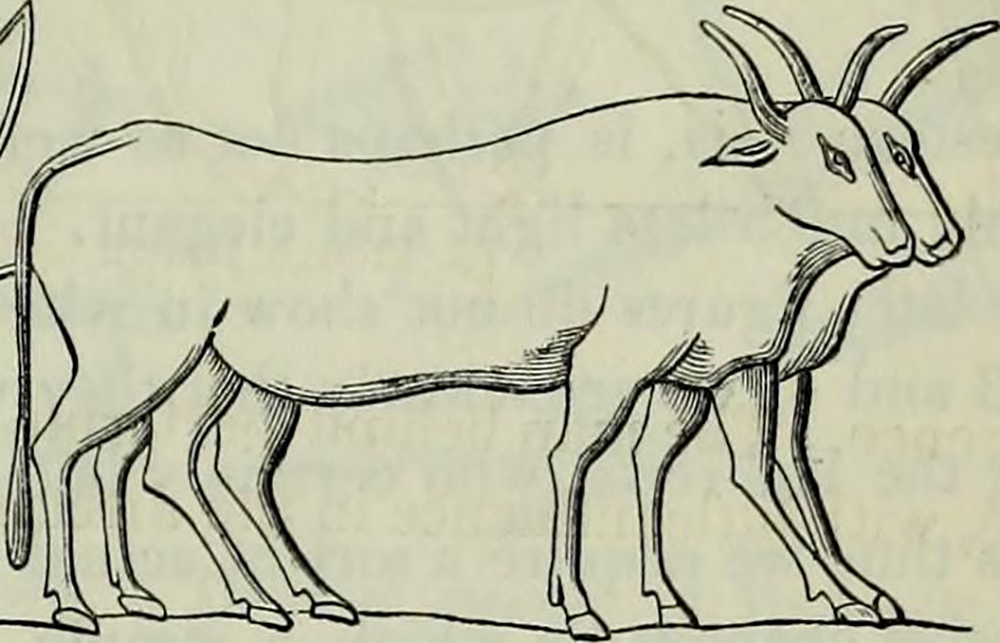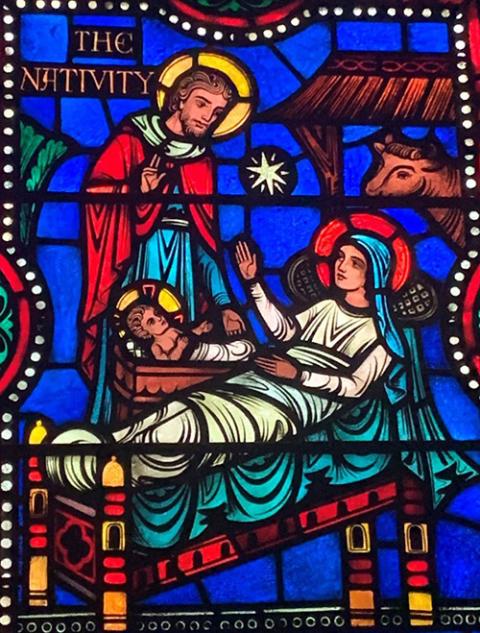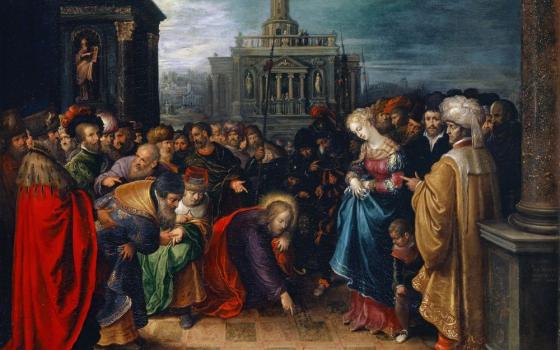
"Offering the Buffalo Skull," a photo of a Mandan Indian man, circa 1908 (Library of Congress Prints and Photographs Division/Edward S. Curtis)
At St. Peter Catholic Church in Fort Yates, North Dakota, on the Standing Rock Indian Reservation, there is a buffalo skull next to the tabernacle. When I researched why, I learned that all Catholic churches should have one, not to appropriate Lakota culture, but to recover a lost teaching at the heart of salvation history.
Upon seeing the skull in St. Peter for the first time, I assumed it was a product of inculturation — the incorporation of local cultural symbols and practices into Catholic liturgy. The buffalo skull has significant cultural meaning for the Lakota people. But as it turns out, it's also an image of Christ drawn from Scripture and Catholic tradition.
Traditionally, the buffalo was the most important source of food and provided a wide range of the necessities of life. The buffalo willingly gave their lives that the people might live, and traditional ways honored this sacrifice. Spiritually, Servant of God Nicholas Black Elk taught in his book The Sacred Pipe that the buffalo was the chief of all the four-leggeds and its body represented the universe.
These are beautiful teachings about the buffalo and what it represents, but is it appropriate to inculturate a skull within the church? Or, as some may worry, does it amount to syncretism or idolatry?
One only need think back to the Pachamama controversy in Rome in 2018, when critics broke into a church, stole an Indigenous statue and threw it into the Tiber River, to know that inculturation can be an emotionally charged issue in the church.
While inculturation may be a new term for some people and a growing area of scholarship, the process of inculturation is not new. It has been integral to the life of the church since the time of Jesus.
Pope Benedict XVI explained in The Spirit of the Liturgy how early Christians — following the Jewish synagogue tradition — adopted for their church buildings the form of Roman public buildings called by the Greek name basilica. Implicit is a remarkable claim that even an important symbol of an empire that was systematically killing the community could be inculturated, and even become the dwelling place of God.
In the case of the buffalo skull, the question of inculturation harkens back to the oldest traditions of the faith.

Illustration of biblical animals from a 19th-century book (Flickr/Internet Archive Book Images)
Indeed, the buffalo skull embodies what countless people of the church sing each day in the Benedictus of Morning Prayer:
Et erexit cornu salutis nobis
in domo David pueri sui.And has raised up a horn of salvation for us
in the House of David, his servant [Luke 1:69].
Or at least, these are the words they should be singing. Many translations, including those used in the Liturgy of the Hours, say "mighty savior" instead of "horn of salvation," leaving the image of the skull hidden. Unlike for the Lakota, horns are so insignificant to modern peoples that they are often overlooked, translated out of existence.
Yet if Jesus and his community were asked what "raised up a horn for salvation" means, they would likely relate a wide array of stories, teachings and practices, not peripheral to but at the very center of their identity and relationship with God.
For Hebrew people, horns represented power and strength. This idea comes from considering the bull, particularly the auroch, a wild species from which domesticated cattle descended. In the Bible, horns often represent kings, particularly in the Book of Daniel and the Book of Revelation (Daniel 7:7-8, 24; Revelation 5:6, 13:1, 11). The horn is also a prophecy of messianic power — "I will make a horn sprout for David" (Psalm 132:17). For these and other reasons, Moses is often depicted with horns.
Horns were not only symbols of Israel and leaders but at the very heart of Hebrew ceremony at the Temple in Jerusalem. The sacrifice of horned oxen and rams was an essential part of liturgies. Like Moses' head, horns adorned the four corners of two altars of the Temple, one altar for the twice-daily sacrifice of incense and the other for the sacrifice of oxen and rams. The Temple altars and sacrifices structured the economy of Israel as horned animals streamed to Jerusalem from hundreds of miles away.

An auroch is depicted on the Ishtar Gate, constructed in 575 B.C. in the city of Babylon, now displayed in the Pergamon Museum in Berlin. (NCR photo/Teresa Malcolm)
Horns are part of the Old Covenant but also at the heart of the New Covenant. In fact, Jesus quotes a reference to horns from Psalm 22 in his last words on the cross in the Gospels of Matthew and Mark: "My God, my God, why have you forsaken me?"
Jesus is quoting the beginning of Psalm 22, a Psalm of thanksgiving. Biblical scholar Scott Hahn points out that the psalm is an extended answer to the psalm's opening question. In it, the narrator describes his desperate situation — surrounded by dogs, encircled by wild bulls, mocked by roaring lions, hands and feet pierced — pleads for help and remembers the Lord's faithfulness. The last third of the psalm gives thanks and praise, then forecasts cosmic triumph.
The current Catholic translation (and many others) is missing the fulcrum on which the whole Psalm and thus salvation history turns. Verse 22 is translated as, "Save me ... from the horns of wild bulls," but, according to Scripture scholars Peter Craigie and Marvin Tate, it would be better translated as "From the horns of the wild oxen you have answered me!" The figurative translation leaves out God's action.
Advertisement
But God answering from the horns? This doesn't seem to make sense. Yet "from the horns" is from where God spoke to Zechariah through the angel Gabriel in the Gospel of Luke: "The angel of the Lord appeared to him, standing at the right of the altar of incense" (Luke 1:11). Looking back to the Book of Exodus, we know the altar of incense was horned (Exodus 37:25).
In Hebrew tradition, oxen are not only or even primarily the sacrifice, but rather represent the nature of God and God's salvific power. Again, it's hidden in a convoluted passage. Balaam, in describing Israel's Exodus in Numbers 24:8, says, "They have the like of a wild ox's horns: God who brought them out of Egypt."
Most likely, God is the ox. The best translation, according to biblical scholar Timothy Ashley, is "God brings them out of Egypt with horns (viz., might) like that of a wild ox."
God, the Wild Ox, bestows power on God's anointed. In Psalm 92:11 — "You have given me the strength of a wild ox; you have poured rich oil upon me" — again, the translation leaves out horns. According to biblical scholar Robert Alter, a better translation is: "And You raise up my horn like the wild ox." In the Talmud, the psalm is understood to foreshadow the messianic age.
Arriving at the birth of Jesus, many Nativity scenes include an ox and an ass, evoking Isaiah 1:3. In the Nativity window in the church I attend in Montpelier, Vermont, there is only an ox. It's likely meant to portray Job 39:9: "Will the wild ox consent to serve you, or pass the nights at your manger?"
The window's image shows their mutual power. The Christ Child and ox hold each other's gaze, emphasizing the divine power of the Horn of Salvation, who will on the cross cite Psalm 22 — in the words of the Darby translation, "Yea, from the horns of the buffaloes hast thou answered me."
While inculturation is the source of the presence of the buffalo skull next to the tabernacle at St. Peter in Fort Yates, it is an incredible example of what inculturation is supposed to do: reveal underappreciated or hidden aspects of the faith. It uncovers what we could call the tendency for "negative syncretism," how our many unnoticed cultural biases shape our understanding of the faith and also impose it on others, domesticating the wildness of its authentic message.
In this case, the Wild Ox who dies to bring us life with the power of his horns.








